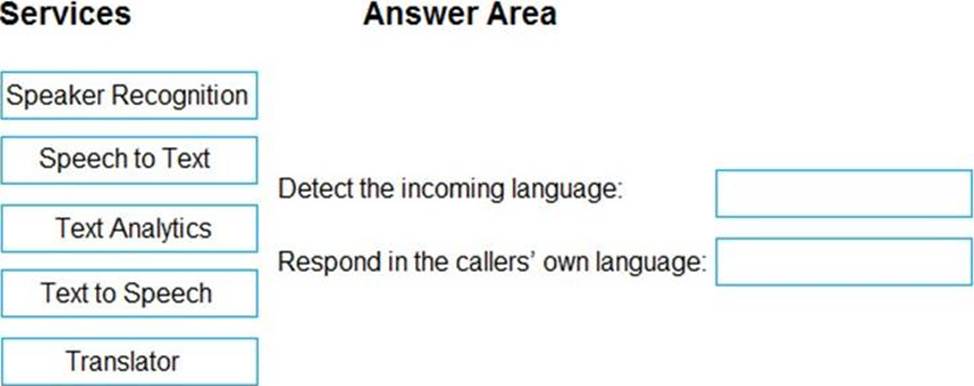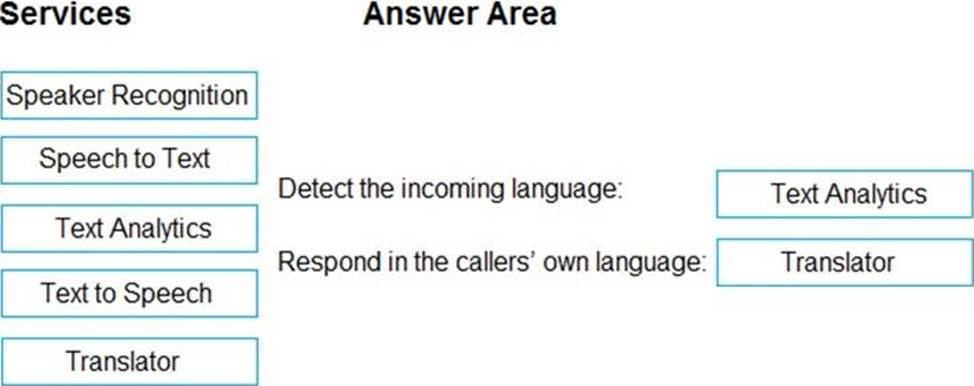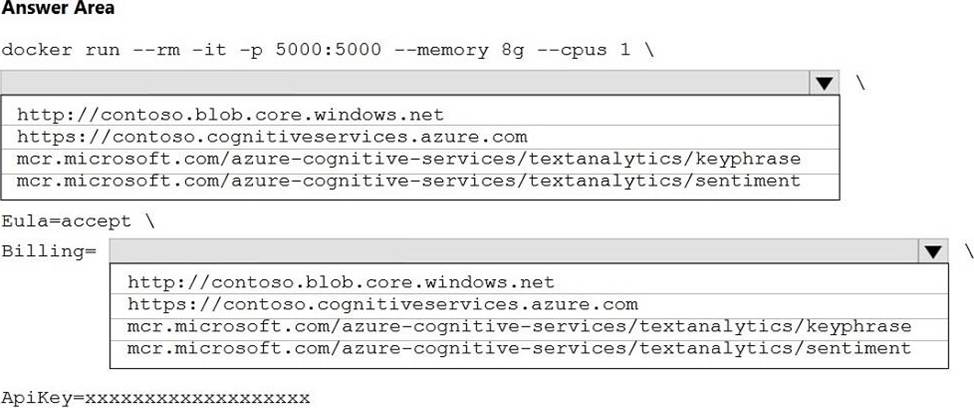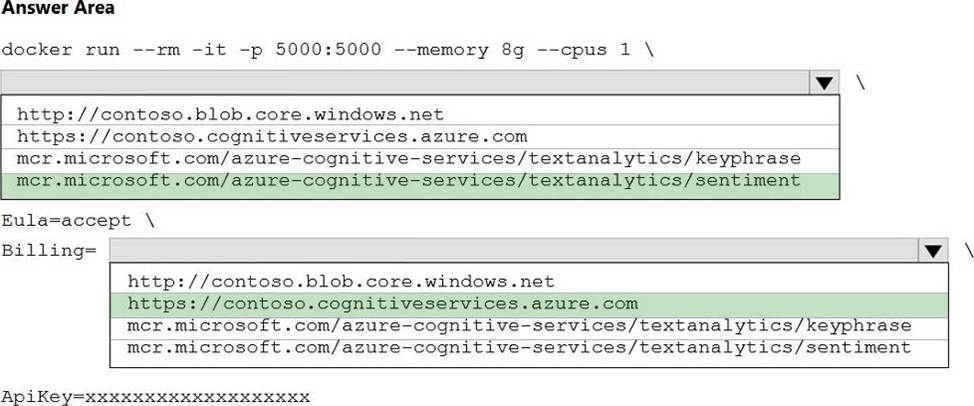Practice Free AI-102 Exam Online Questions
You are developing an application that will use Azure Cognitive Search for internal documents.
You need to implement document-level filtering for Azure Cognitive Search.
Which three actions should you include in the solution? Each correct answer presents part of the solution. NOTE: Each correct selection is worth one point.
- A . Send Azure AD access tokens with the search request.
- B . Retrieve all the groups.
- C . Retrieve the group memberships of the user.
- D . Add allowed groups to each index entry.
- E . Create one index per group.
- F . Supply the groups as a filter for the search requests.
CDF
Explanation:
Your documents must include a field specifying which groups have access. This information becomes the filter criteria against which documents are selected or rejected from the result set returned to the issuer.
D: A query request targets the documents collection of a single index on a search service.
CF: In order to trim documents based on group_ids access, you should issue a search query with a group_ids/any(g:search.in(g, ‘group_id1, group_id2,…’)) filter, where ‘group_id1, group_id2,…’ are the groups to which the search request issuer belongs.
Reference: https://docs.microsoft.com/en-us/azure/search/search-security-trimming-for-azure-search
You are examining the Text Analytics output of an application.
The text analyzed is: "Our tour guide took us up the Space Needle during our trip to Seattle last week."
The response contains the data shown in the following table.

Which Text Analytics API is used to analyze the text?
- A . Sentiment Analysis
- B . Named Entity Recognition
- C . Entity Linking
- D . Key Phrase Extraction
DRAG DROP
You need to develop an automated call handling system that can respond to callers in their own language. The system will support only French and English.
Which Azure Cognitive Services service should you use to meet each requirement? To answer, drag the appropriate services to the correct requirements. Each service may be used once, more than once, or not at all. You may need to drag the split bat between panes or scroll to view content. NOTE: Each correct selection is worth one point.


Explanation:
Box 1: Text Analytics
The Language Detection feature of the Azure Text Analytics REST API evaluates text input for each document and returns language identifiers with a score that indicates the strength of the analysis.
Box 2: Translator
Translator is a cloud-based neural machine translation service that is part of the Azure Cognitive Services family of REST APIs. Translator can be used with any operating system and powers many Microsoft products and services used by thousands of businesses worldwide to perform language translation and other language-related operations.
Reference:
https://docs.microsoft.com/en-us/azure/cognitive-services/text-analytics/how-tos/text-analytics-how-to-language-detection
https://docs.microsoft.com/en-us/azure/cognitive-services/translator/translator-overview
DRAG DROP
You have a monitoring solution that uses the Azure Al Anomaly Detector service.
You provision a server named Server! that has intermittent internet access.
You need to deploy the Azure Al Anomaly Detector to Server 1.
Which four actions should you perform in sequence? To answer, move the appropriate actions from the list of actions to the answer area and arrange them in the correct order.


HOTSPOT
You plan to deploy a containerized version of an Azure Cognitive Services service that will be used for text analysis.
You configure https://contoso.cognitiveservices.azure.com as the endpoint URI for the service, and you pull the latest version of the Text Analytics Sentiment Analysis container.
You need to run the container on an Azure virtual machine by using Docker.
How should you complete the command? To answer, select the appropriate options in the answer area. NOTE: Each correct selection is worth one point.


Explanation:
Box 1: mcr.microsoft.com/azure-cognitive-services/textanalytics/sentiment
To run the Sentiment Analysis v3 container, execute the following docker run command. docker run –rm -it -p 5000:5000 –memory 8g –cpus 1 mcr.microsoft.com/azure-cognitive-services/textanalytics/sentiment Eula=accept
Billing={ENDPOINT_URI}
ApiKey={API_KEY} is the endpoint for accessing the Text Analytics API. https://<your-custom-subdomain>.cognitiveservices.azure.com
Box 2: https://contoso.cognitiveservices.azure.com
{ENDPOINT_URI} is the endpoint for accessing the Text Analytics API: https://<your-custom-
subdomain>.cognitiveservices.a The endpoint for accessing the Text Analytics API. zure.com
Reference: https://docs.microsoft.com/en-us/azure/cognitive-services/text-analytics/how-tos/text-analytics-
how-to-install-containers?tabs=sentiment
DRAG DROP
You need to analyze video content to identify any mentions of specific company names.
Which three actions should you perform in sequence? To answer move the appropriate actions from the list of actions to the answer area and arrange them in the correct order.


You are building a chatbot for a travel agent. The chatbot will use the Azure OpenAI GPT 3.5 model and will be used to make travel reservations.
You need to maximize the accuracy of the responses from the chatbot.
What should you do?
- A . Configure the model to include data from the travel agent’s database.
- B . Set the Top P parameter for the model to 0.
- C . Set the Temperature parameter for the model to 0.
- D . Modify the system message used by the model to specify that the answers must be accurate.
You plan to provision a QnA Maker service in a new resource group named RG1.
In RG1, you create an App Service plan named AP1.
Which two Azure resources are automatically created in RG1 when you provision the QnA Maker service? Each correct answer presents part of the solution. NOTE: Each correct selection is worth one point.
- A . Language Understanding
- B . Azure SQL Database
- C . Azure Storage
- D . Azure Cognitive Search
- E . Azure App Service
DE
Explanation:
Reference: https://docs.microsoft.com/en-us/azure/cognitive-services/qnamaker/how-to/set-up-qnamaker-service-azure?tabs=v1#delete-azure-resources
"When you create a QnAMaker resource, you host the data in your own Azure subscription. Azure Search is used to index your data." & "When you create a QnAMaker resource, you host the runtime in your own Azure subscription. App Service is the compute engine that runs the QnA Maker queries for you."
Note: This question is part of a series of questions that present the same scenario. Each question in the series contains a unique solution that might meet the stated goals. Some question sets might have more than one correct solution, while others might not have a correct solution.
After you answer a question in this section, you will NOT be able to return to it. As a result, these questions will not appear in the review screen.
You create a web app named app1 that runs on an Azure virtual machine named vm1. Vm1 is on an Azure virtual network named vnet1.
You plan to create a new Azure Cognitive Search service named service1.
You need to ensure that app1 can connect directly to service1 without routing traffic over the public internet.
Solution: You deploy service1 and a public endpoint to a new virtual network, and you configure Azure Private Link.
Does this meet the goal?
- A . Yes
- B . No
B
Explanation:
Reference: https://docs.microsoft.com/en-us/azure/cognitive-services/cognitive-services-virtual-networks?tabs=portal#use-private-endpoints
You have an Azure OpenAI model named All.
You are building a web app named App1 by using the Azure OpenAI SDK. You need to configure App1 to connect to All.
What information must you provide?
- A . the endpoint, key, and model name
- B . the deployment name, endpoint. and key
- C . the endpoint, key, and model type
- D . the deployment name, key, and model name
